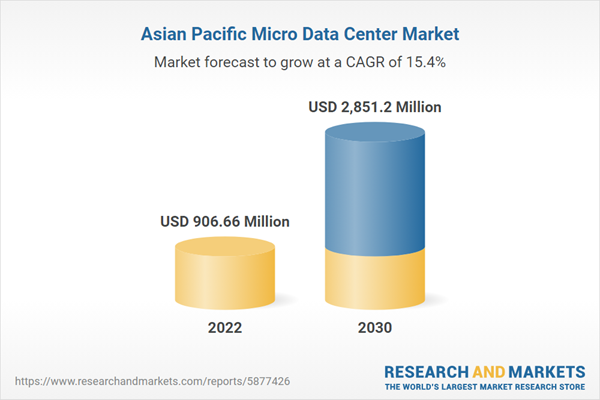Increasing Proliferation of Cloud-based Services Fuels the Asia Pacific Micro Data Center Market
Cloud computing provides a cost-effective way to handle the data, enabling organizations to store and process it in a centralized location without investing in expensive hardware and infrastructure. Due to the growth of cloud computing services, various organizations are shifting their IT infrastructure to the cloud, as they often require facilities to leverage additional space, power, and cooling for servers, storage, and networking equipment. This is contributing to the adoption of data services. The integration of cloud technologies into interconnected devices and systems has increased their usage, resulting in a growing need for high-speed, low-latency network connectivity. The data center providers offer a secure hardware environment to store and access data, which is essential to support IoT and cloud-based applications. It also helps save overall costs over establishing their own data center.Additionally, with the growing adoption of cloud-based technologies, key players operating in the Asia Pacific micro data center market are establishing new units for business deliveries to enhance customer's accessibility to the cloud and digital infrastructure. For instance, in September 2021, Vantage Data Centers opened its new facility in APAC due to two acquisitions and an equity raise of US$ 1.5 billion led by stakeholder DigitalBridge Investment Management. The expansion offered cloud-based services across Tokyo and Osaka (Japan), Hong Kong (China), Kuala Lumpur (Malaysia), and Melbourne (Australia). The launch of new data centers in the country is attracting more customers to leverage the services of advanced technologies such as cloud-based services. Thus, the rising proliferation of cloud-based services is driving the growth of the Asia Pacific micro data center market.
Asia Pacific Micro Data Center Market Overview
Asia Pacific (APAC) is a diverse region with a large population and growing digital economy, contributing to the surge in demand for localized data processing and storage solutions. APAC has been at the forefront of edge computing adoption due to the proliferation of IoT devices, smart cities initiatives, and the need for real-time data processing. APAC has witnessed a significant increase in internet penetration rates, leading to a surge in data consumption and the need for localized data processing. According to GSM Association, the IT industry has been instrumental in extending connectivity across the world. In 2021, the number of internet subscribers reached 4.2 billion globally. In APAC, there were 59% of internet subscribers in 2021, projected to reach up to 62% by 2025. The rise of edge computing is directly linked to increasing internet usage. Micro data centers play a crucial role in supporting edge computing infrastructure by bringing compute resources closer to the source of data, reducing latency, and improving performance. These data centers are crucial in supporting edge computing by deploying small-scale data centers in geographically distributed locations, including cities, to ensure rapid data processing and reduce reliance on centralized data centers. Micro data centers help address the growing demand for low-latency applications and services, such as video streaming, e-commerce, and mobile gaming.Asi
a Pacific Micro Data Center Market Revenue and Forecast to 2030 (US$ Million)
Asia Pacific Micro Data Center Market Segmentation
Based on rack type, the Asia Pacific micro data center market is bifurcated into single rack and multi rack. The single rack segment held a larger share in 2022.Based on organization size, the Asia Pacific micro data center market is bifurcated into large enterprises and SMEs. The large enterprises segment held a larger share in 2022.
Based on end user, the Asia Pacific micro data center market is segmented into BFSI, retail, IT and telecom, manufacturing, healthcare, and others. The IT and telecom segment held the largest share in 2022.
Based on country, the Asia Pacific micro data center market is segmented into Australia, China, Japan, Indonesia, the New Zealand, Singapore, Thailand, Vietnam, the Philippines, Bangladesh, Sri Lanka, and the Rest of APAC. China dominated the Asia Pacific micro data center market in 2022.
Hitachi Ltd, Rittal GmbH & Co KG, Legrand SA, Schneider Electric SE, Vertiv Group Corp, Eaton Corp Plc, Hewlett Packard Enterprise Development LP, Zella DC, Delta Electronics Inc, and Huawei Technologies Co Ltd are some of the leading companies operating in the Asia Pacific micro data center market.
Reasons to Buy
- Save and reduce time carrying out entry-level research by identifying the growth, size, leading players, and segments in the Asia Pacific micro data center market.
- Highlights key business priorities in order to assist companies to realign their business strategies
- The key findings and recommendations highlight crucial progressive industry trends in the Asia Pacific micro data center market, thereby allowing players across the value chain to develop effective long-term strategies
- Develop/modify business expansion plans by using substantial growth offering developed and emerging markets
- Scrutinize in-depth Asia Pacific market trends and outlook coupled with the factors driving the Asia Pacific micro data center market, as well as those hindering it
- Enhance the decision-making process by understanding the strategies that underpin commercial interest with respect to client products, segmentation, pricing, and distribution
Table of Contents
Companies Mentioned
- Hitachi Ltd
- Rittal GmbH & Co KG
- Legrand SA
- Schneider Electric SE
- Vertive Group Corp
- Eaton Corp Plc
- Hewlett Packard Enterprise Development LP
- Zella DC
- Delta Electronics Inc
- Huawei Technologies Co Ltd
Table Information
| Report Attribute | Details |
|---|---|
| No. of Pages | 112 |
| Published | February 2024 |
| Forecast Period | 2022 - 2030 |
| Estimated Market Value ( USD | $ 906.66 Million |
| Forecasted Market Value ( USD | $ 2851.2 Million |
| Compound Annual Growth Rate | 15.4% |
| Regions Covered | Asia Pacific |
| No. of Companies Mentioned | 10 |









